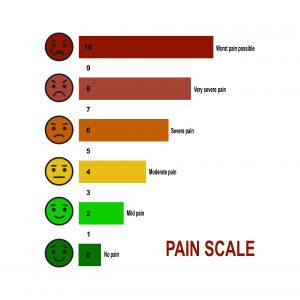Personal Injury Primer: Demonstrating Exacerbation of Pre-existing Injuries

Demonstrating exacerbation of pre-existing injuries through medical records documentation.
Have a client with extensive pre-accident complaints and injuries? A careful review of pre – and post-accident medical documentation along with direct conversations with your client can help you establish that his or her pre-existing complaints were exacerbated by the accident in question.
Here’s how:
1. Carefully review pre-accident versus post-accident pain score ratings.
Patients are routinely asked to rate their pain on a 1 to 10 scale with 10 being the worst pain possible. Gather information for each pre-accident visit’s pain scale rating and note in a chart or graph. For instance, you may see that prior to the accident on January 2, 2016, the client complained of pain at a “3” out of 10, on February 10, 2016, a “4” out of 10, and on April 20, 2016, a “3” out of 10. This gives you a range of pain complaints about the pre-existing period that shows this patient had minimal to moderate pain during this time.
Next, gather information for post-accident visits’ pain scale rating and note in a chart or graph. Let’s assume the above-referenced client was in an accident on May 5, 2016. Subsequent visits to the orthopedist and chiropractor documented that the pain scale complaints had increased to a “9” on May 10, 2016, a “9” on June 10, 2016, a “7” July 12, 2016, and an “8” on August 11, 2016. Comparison of the pre-accident versus post-accident pain scales would definitively show an increase in post-accident pain complaints.
2. Analyze documentation such as the Pain Quality Assessment Scale regarding the quality and frequency of pain.
For instance, pre-accident records might document that the client had “dull” or “aching” pain on an intermittent basis. You will be able to show an exacerbation when post-accident records show that the client now has “shooting” or “stabbing” pain on a frequent or constant basis.
3. Inspect pre-accident versus post-accident functional screenings and indexes.
Physical therapists and chiropractors use functional screenings and indexes to assess the effectiveness of their treatments. One such scale is the Patient Specific Functional Scale. Inspect pre-accident records regarding functional abilities prior to the accident and compare to post-accident records regarding functional abilities. For instance, the client might have been able to lift 20 pounds prior to the accident and can only lift 5 pounds after the accident. Or, the patient regularly slept 8 hours per night prior to the accident and post-accident only sleeps 5-6 hours per night due to pain or trauma. Another example might be an activity review: prior to the accident the client had occasional low back pain but enjoyed aerobics. Post-accident, the aerobic activity causes so much low back pain that the client is no longer able to participate.
4. Study pre versus post accident objective examinations by physicians, physical therapists, and chiropractors.
Objective examinations documenting the physical manifestations of symptoms can further serve to demonstrate an exacerbation. Did the pre-accident exam show a slightly below normal cervical rotation of 80 degrees versus the post-accident exam showing severely decreased rotation of 60 degrees? Was there mild tenderness in the lower spine prior to the accident and severe tenderness after the accident? Or did palpation reveal mild spasm prior to the accident but severe spasm after? Any of the above findings could reinforce an exacerbation of a prior complaint.
5. Take a close look at pre versus post-diagnostic studies.
Even when there is no obvious post-accident change such as a disc herniation or annular tear (tear in the lining of the disc), there may be more subtle changes that were caused by the accident in question. Was there a decrease in lordotic curvature (normal curvature of neck/low back) in any area of the spine after the accident? This can be caused by car crashes when neck ligaments are damaged. Was there a disc bulge with no other manifestation prior to the accident but after the accident, there is a disc bulge which indents the thecal sac? Or was there anterolisthesis (forward placement of one disc above another) of .2 mm before the accident but anterolisthesis of .6 mm after the accident? Each of the above instances shows there was injury before the accident and worsened condition after the accident.
6. Investigate pre-accident versus post-accident medication usage.
Was the patient taking Ibuprofen and Flexeril for symptoms before the accident but after the accident had to begin using Lortab or Ultram? Did intermittent doses of Lortab before the accident reduce pain but now the patient requires an increased dose? Changes in dosage, frequency, or the type of medications pre-versus post accident may further substantiate a worsened condition.
7. Scrutinize pre-accident versus post-accident treatments.
This writer recently reviewed a case in which the plaintiff had an extensive history of medical treatments for neck and back pain prior to the accident. However, a review of the treatments showed that although the client had undergone prior steroid injections, the treatments had increased post-accident. He had only one cervical steroid injection in the eight years prior to the accident. In the 3 year period after the accident, he had 4 cervical steroid injections due to aggravated neck pain. Increased visits to health care providers and increased treatments can build your client’s claim for exacerbation of prior injuries.
8. Lastly, visit with the client to inquire regarding how the accident may have affected them in general.
Did they have perfect work attendance prior to the accident and have missed work on a number of occasions due to pain and/or doctor visits after? Did the client have an active social life or enjoy volunteering prior to the accident and post-accident finds it more difficult to enjoy these activities due to an increase in symptoms? Or has the client become more irritable, moody with family/friends as compared to pre-accident? While these issues are subtler than increases in pain or treatments, they may still show decreased enjoyment in life.
We hope these tips will help you to mount a convincing argument for your client’s post-accident exacerbation of pre-existing injuries.
Are you saying to yourself, “This is all a great idea, but I simply don’t have time to do this kind of detailed review of the records?”
